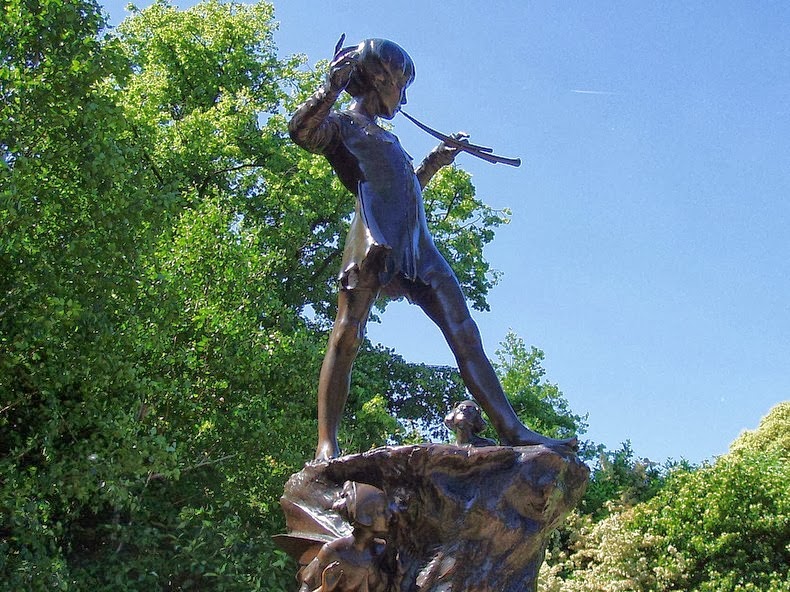Fairy tales have been used as bed time stories by parents for generations. They have entertained kids, inspired writers, and found prominence in contemporary pop culture. Many fairy tale characters have been immortalized in statues that stand on public squares, in gardens or on the riverside. Amusing Planet takes you around the world on a hunt for the most famous statues based on characters from the magical world of fairy tales.
The Little Mermaid in Copenhagen
The Little Mermaid statue is located at the Langelinie promenade, about 10-minute walk away from the cruise ship pier in Copenhagen, Denmark. The near life-size, bronze statue is seated on a rock by the waterside. Based on the 1837 fairy tale by Hans Christian Andersen, the small and unimposing statue is an icon of the city, and has been a major tourist attraction since 1913.
The statue has been subjected to vandalism numerous times during her 100-year existence. She has been dowsed in paint several times, had her right arm amputated, been decapitated three times, and even pushed from her rock in 2003. Twice she was draped in burqa and once a dildo was attached to the statue's hand. Fortunately, each time the statue was restored. In 2006, Copenhagen officials announced that the statue may be moved farther out in the harbor, so as to avoid further vandalism and to prevent tourists from climbing onto it. But this hasn’t happened yet.
Fremont Troll in Seattle
The Fremont Troll is a 18-feet high concrete sculpture located under the north end of the George Washington Memorial Bridge (also known as the Aurora Bridge). It is clutching an actual Volkswagen Beetle, bearing California license plate, as if it had just swiped it from the roadway above.
Based on the Scandinavian fairytale Three Billy Goats Gruff, the statue was built by four Seattle area artists for the Fremont Arts Council in 1990, to rehabilitate a particularly unsightly area in the neighborhood. There are plenty of places to pose, and visitors are encouraged to clamber on him or try to poke out his one good eye.
Peter Pan in Kensington Gardens, London
A bronze statue of Peter Pan, "the boy who wouldn't grow up," is found in Kensington Gardens, next to Hyde Park, London. The exact location was chosen by Peter Pan's author, J.M. Barrie. Barrie lived close to Kensington Gardens and published his first Peter Pan story in 1902, using the park for inspiration. In his Peter Pan tale, The Little White Bird, Peter flies out of his nursery and lands beside the Long Water lake - on the spot where the statue now stands.
Barrie began planning the Peter Pan statue in 1906. He took photos of the six-year-old Michael Llewelyn Davies wearing a special Peter Pan costume to help a sculptor recreate his vision. In 1912, he found the man to make the statue, Sir George Frampton, and by 1st May that year, the sculpture was in place in Kensington Gardens.


Alice in Wonderland in Central Park, New York
Probably the most beloved sculpture of Central Park, New York, is a depiction in bronze of a group of characters from Lewis Carroll's 1865 classic tale Alice's Adventures in Wonderland. The sculpture was patterned off the original illustrations of John Tenniel that were used in the first published edition of the book. The obvious centerpiece of the work, Alice, who depicts the face of Creeft’s daughter, Donna, is pictured sitting on a giant mushroom reaching toward a pocket watch held by the White Rabbit. Peering over her shoulder is the Cheshire Cat, surrounded by the Dormouse, Alice's cat Dinah, and the Mad Hatter -- a caricature of George Delacorte. The statue stands 11 feet high and kids are invited to climb, touch and crawl all over Alice and her well loved friends.
Make Way for Ducklings in Boston
The Make Way for Ducklings statues depicting Mrs. Mallard leading her famous brood of eight ducklings are a very popular feature of the Boston Public Gardens. The statues are based on the popular children's story written by Robert McCloskey and published in 1941. The book follows a pair of mallard ducks who select an island in the park's lagoon as a spot to raise their family.
Town Musicians of Bremen in Bremen, Germany
The Town Musicians of Bremen from the 1857 Brothers Grimm fairy tale are immortalized in bronze on the western side of the town hall in Bremen. The donkey, dog, cat and rooster have been standing there since 1951. In the tale, the animals leave their masters in search of a life of freedom without owners. They choose Bremen as their destination but take over a cottage from robbers on the way. The statue shows them standing on each other's backs – a stunt they did to drive away the robbers in order to gain food.
The Pied Piper of Hameln in Hameln Germany
Located on the River Weser in Lower Saxony, Germany, the town of Hameln was made popular by the medieval story that tells of a tragedy that befell the town in the thirteenth century. According to legend, in 1284 the town was suffering from rat infestation. A man dressed in colored clothes appeared and agreed to get rid of the rats in return for a payment. The man played a musical pipe to lure the rats into the Weser River. Despite his success, the mayor refused to pay the rat-catcher the full amount of money. The man left the town angrily, but vowed to return some time later, seeking revenge. On Saint John and Paul's day while the inhabitants were in church, he played his pipe once again, this time attracting the children of Hamelin. One hundred and thirty boys and girls followed him out of the town and were never seen again.
All around town, there are signs, logos and numerous sculptures of rats and Pied Piper themes which businesses have capitalized on.



























Very interesting! THX
ReplyDelete